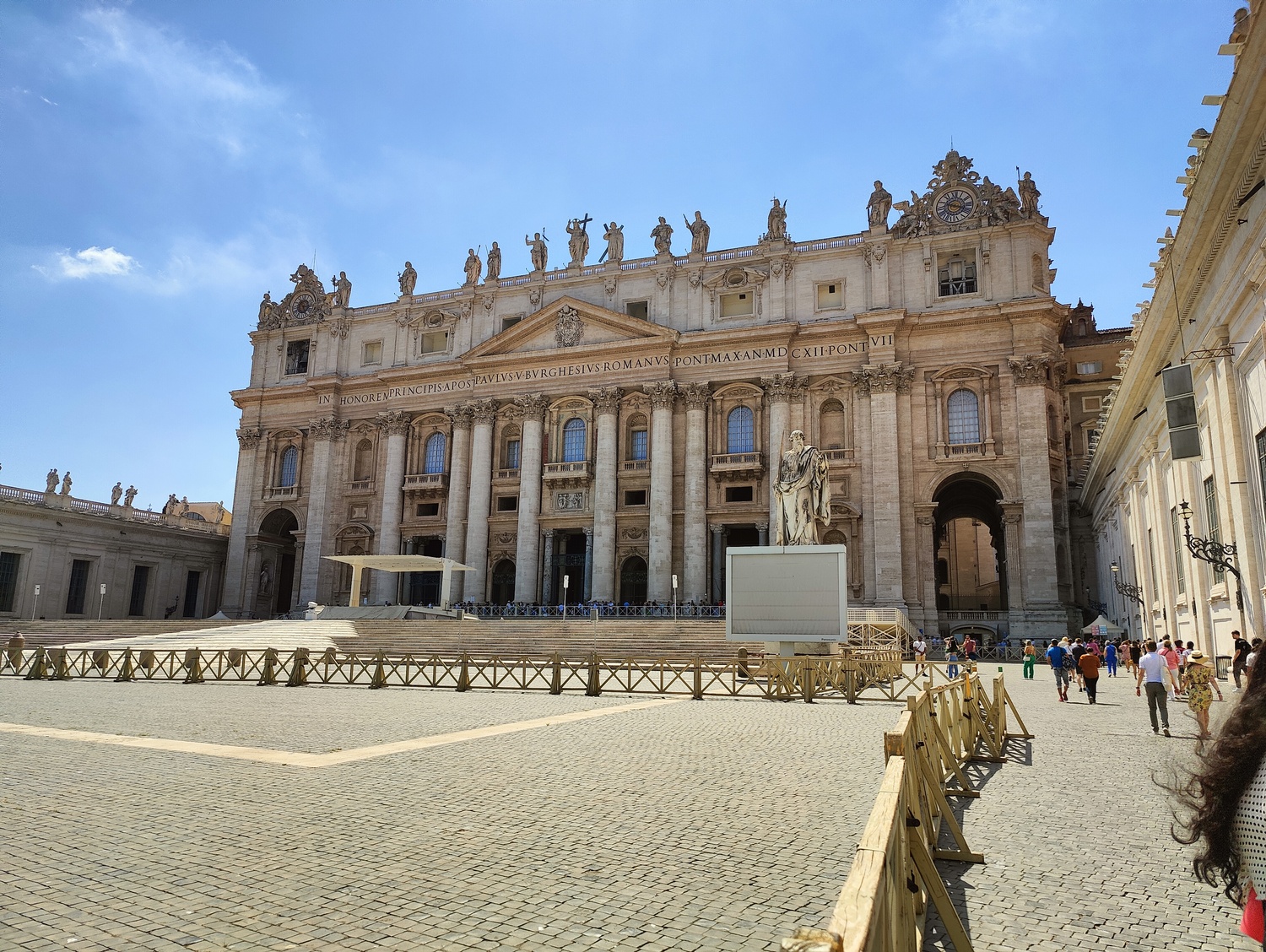Please excuse that this is being posted a bit late today! This was my son J’s first day out of isolation since recovering from the attack of Covid he picked up in the airport on the way home. It’s been a busy day, but here’s the promised report on St. Peter’s.
The Papal Basilica of St. Peter in the Vatican, more commonly simply known as St. Peter’s Basilica, is the largest church in the world. And boy, does it ever make sure that you know it.

The reason it’s the biggest church in the world is simple: nobody except the Catholic Church has either the money or the use for anything bigger. And the Catholic Church won’t allow its members to build anything that could steal the thunder from St. Peter’s.
We went to St. Peter’s immediately after our walk through the Vatican galleries and the Sistine Chapel. One of my first thoughts was that it was a pity that the Church insisted on making such a big thing out of its being, well, big. Because, yes, it is big, but so what? Anyone can build big — that doesn’t take any real talent. St. Peter’s is beautiful in itself, and contains some incredible art treasures. It’s so much more interesting, in so many ways, than just its size.
The Basilica was mostly the work of Julius II, the same guy who established the Vatican galleries. It was designed by a handful of architects including Michelangelo, and it derives it’s name from being the alleged burial place of St. Peter, the alleged first pope. Because of this association, many popes have chosen to be buried there. There are papal tombs everywhere you look around the edges of the main sanctuary.
Close to one of them sits the most dramatic of the many statues in the basilica: Michelangelo’s Pietà. The Pietà is one of Michelangelo’s early works and it’s largely the piece that made him famous. It’s a life-sized (though deliberately disproportionate, in order to make the positioning work) image of Mary holding the dead body of her son Jesus on her lap, immediately after the Crucifixion. The faces are incredibly precise; you can see the emotion on them the way you could on a movie actor’s during a good close-up. Jesus’ serenity and certainty; Mary’s combined grief and trusting acceptance — it’s all here.


Moving on from the Pietà, we tried to get our bearings in the enormous church. It’s laid out in the standard cross shape that would normally signify a cathedral, though technically this isn’t one because it isn’t the seat of a bishop. There are individual chapels all around the edge, and the enormous central nave has a barrel vault ceiling, topped with the dome that was Michelangelo’s design. You can actually go up inside the dome, but I didn’t know that at the time or I would have asked to. Our guide didn’t bring up the possibility… I’m not sure if that was because she saw that I was already fading in my walking energy and thought it would be too much for me, or if the dome wasn’t open when we were there, or what; but despite hearing afterwards that it can be done, we didn’t find out about the possibility at the time. I’ll try to do it next time I get to Rome, because it’s reputed to be even more gorgeous up close than it is from below, and that was stunning. Glass panels let the Mediterranean sunlight pour in, and mosaics around the edges hint at the ancient Roman world’s influence, even here in the stronghold of later Roman Catholicism. The two pillars of the city’s history never really leave each other alone for very long… ancient Rome is always there, lurking beneath the church — or in this case, suspended way above it.


The floor has marks in it, indicating how far along the massive building other large churches in the world would come to. This is part of what I mean when I say that St. Peter’s always makes sure you know how big it is. They didn’t have to show you exactly how much bigger they are than anything else, but they did anyway. I wasn’t especially impressed with that.
But I was with the rest of the sculpture in the basilica. I don’t even remember what I was told about it all or who made it, besides the Pieta — I just wandered from one statue to the next, examining everything about them. I’ve never been a huge fan of most still art (though I learned to like painting when we got to Florence) but of the lot, sculpture has always been my favorite.


We left the Basilica in the early evening, and I made a quick stop in one of the Vatican’s gift shops in order to buy a book on the Sistine Chapel. Because I wasn’t allowed to take my own photos there, I wanted to have some of the authorized ones to look at after I got home. Then we set out to look for a taxi.
This would prove to be the most difficult thing we’d tried to do in our entire stay in Rome. There was a taxi strike, it seems, and while our travel agency had known that was coming, they hadn’t expected it to be as much of a big deal as it was.
Strikes in Italy aren’t the same as they are in the United States. For one thing, they aren’t aimed at their employers, and they aren’t usually an effort to obtain better wages or working conditions. They’re a political tactic, aimed at the government. The idea is that an entire industry walks off the job, highlighting to the administration how much the country needs them. They’re almost always only one day.
That’s the part our travel agency got wrong. The taxi strike was scheduled for yesterday. Our guide handled it by asking her husband to give us a lift to and from the Colosseum in their personal (electric) car. After that, it should have been over.
Except it turns out that this time, the taxi drivers were really upset… over what exactly, I never did find out, or at least the answers I got never made sense to me. I think I needed a lot more background in Italian politics in order to understand it. Anyway, instead of their usual one-day strike, they entrenched themselves for Day Two. The agency wasn’t expecting that, and didn’t have an answer for us, or at least not a complete one. They did get us to the Vatican in a hired car from a limousine company, which is considered a different industry from the taxis, and therefore weren’t participating in the strike. But they didn’t know when we were going to be finished with the tour, so they couldn’t set something like that up for us on the way back.
Patricia tried really hard. She spent half an hour on the phone, trying to find somebody she could call, but all the car services were booked up already. Then she went into the streets to try and beg a taxi driver to break ranks, but no luck. There were plenty of taxis on the street, but their drivers were very determined not to take any passengers. I was beginning to think that we had offended St. Christopher, the patron saint of travelers, and he had decided we weren’t going to be allowed to go anywhere.
I had just about used up my ability to walk in the Vatican. Exhausted and in pain, I needed a cool place to sit down. After an hour of wandering downtown Roman streets trying to find a cab, I asked Patricia, “What would you do if you were alone and had to get to our hotel?”
She looked startled and said, “I would take the train, but it is a long trip.”
I shrugged. “Guess we’d better get started, then. It doesn’t look like we’re going to find anything else, right?”
And that’s how we ended up taking public transit with the rest of the Roman rush hour.
It wasn’t actually that long. There was a short bus ride to one of the train hubs, and then a pretty nice commuter railroad line. There was supposed to be another bus at the other end, and I kind of wish there was, because instead Patricia overestimated my ability to walk and decided that we were close enough to the hotel to do the last bit on foot. But the last bit was more than half a mile, and I just didn’t have it. I made it, in increasing pain, until the very last block… and then gave out and finished the trip learning hard on Patricia and J, one arm on each of them.
I was mostly all right after I had a chance to rest in air conditioning and get a shower on the sore hips. But I learned something about how much walking I could and couldn’t expect to be able to do on this trip. After I’d taken care of myself, and ordered us dinner, I got in touch with my travel agent and asked whether there might be any possible way to rent a wheelchair for some of the stops further down the line. You’ll see how that request panned out in a few weeks… I’m not posting spoilers!
Then we packed. Tomorrow, we would leave Rome for Sorrento, Naples, and Herculaneum. Stay tuned!


Leave a Reply